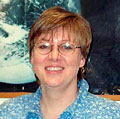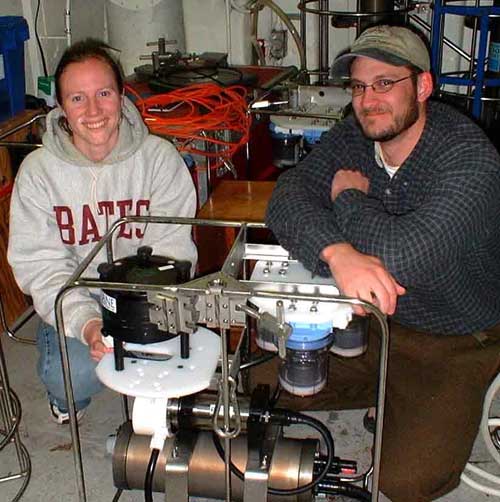 |
|
|
| Author |
Message |
Patty_Cie

Joined: 23 Mar 2004
Posts: 87

|
 Posted:
Thu Jun 03, 2004 9:39 pm Posted:
Thu Jun 03, 2004 9:39 pm |
  |
May 31, 2004 Monday
10:30 PM Alaska time
It is a working holiday here on the Healy. We are approximately 160 km north and 35 km west of Barrow, Alaska sampling EHS 5, the third process station on the East Hanna Shoal high-resolution line. The anticipated time to complete this station is 18 hours. I am writing my journal while waiting for the benthic core sampling to begin; it is tentatively scheduled to start at 1:30 AM.
I write my journals in the Future Lab. Working next to me is Pat Kelly and Kate Hagstrom from the University of Rhode Island. Pat and Kate are collecting samples for Brad Moran. They are here to establish how much organic carbon is sinking from the surface water to the deep ocean basin.
Organic carbon is important. In simplest terms, organic carbon is food for all non-photosynthesizing organisms. Primary producers (phytoplankton) photosynthesize - changing inorganic carbon to organic carbon. The organic carbon can either be consumed by other organisms or be transported from the surface waters to the deeper water when organisms die and sink. Brad, Pat and Kateís hypothesis asserts there is a significant increase in the amount of carbon that sinks from the surface water to deep water from spring to summer.
The procedure they use to establish the amount of organic carbon present in the water and in the sediments is multi-stepped. First they collect water. Most of the groups on the Healy capture water at depth and filter it on the ship. In contrast, Pat and Kate use an in situ pump for water collection. The pump goes into the sea at a predetermined depth and stays there for approximately four hours. While submerged, the pump filters 500 to 1000 liters of water. Using three filters and two filtering cartridges, the pump collects and separates four size ranges of particles and soluble matter from the water. One filter collects particles greater than 100 microns, a second filter collects 53-100 micron particles, and a third filter captures 20-53 micron particles. One filtering cartridge captures 1-20 micron particles and a second cartridge collects dissolved matter in the water.

Kate is rinsing a filter under a protected work area.
When the pumping is complete, Pat and Kate remove the pumpís filters and rinse each particulate sample into a separate beaker. Each beaker sample is refiltered using a grade F, 0.7-micron glass fiber filter (GF/F). The GF/F is put into the drying oven to evaporate the remaining water. The dried GF/F filters are sealed and taken back to the University of Rhode Island. In Rhode Island a slice is removed from the filter and analyzed for the amount of particulate organic carbon (POC). The rest of the filter is sent to another machine to measure the concentration of thorium-234 by radioactive decay. The analysis takes place shortly after the scientists return from the 40-day SBI 04 cruise because thorium-234 decays quickly (it has a 24 day half life) and must be analyzed within 100 days of collection.

Pat and Kate pose with the in situ pump before it is deployed.
The cartridges are also removed from the pump. They are put into a 575 degree C furnace located on Healyís back work deck. The cartridge material is burned off leaving an ash containing the collected particles, sea salt and manganese residue from the cartridge. Using a Gamma Spectrometer, Pat and Kate measure the ash for the thorium-234. A Gamma Spectrometer measures specific quantities of radioactivity. It is able to determine the number of atoms that have decayed for a specific isotope. The electronics on the Gamma Spectrometer works at such a very high voltage that they must be cooled with liquid nitrogen to keep them at a working temperature.

Kate and Pat are transferring liquid nitrogen.
From past scientific research, scientists know how much thorium should be in water if no particles existed. In reality, particles exist, thorium sticks to particles and particles sink carrying the thorium with them. So, Brad, Pat and Kate take the amount of thorium that is suppose to be in water, subtract the amount actually found in the water, and ascertain how much thorium is missing. This is called the thorium deficit. From the thorium deficit they use mathematical formulas to find the thorium flux. The thorium flux is how fast and how much thorium is moved from the surface water to the deep water. The group uses another mathematical formula (thorium-234 flux X POC/thorium-234) to calculate the POC flux. POC flux is how much of the available organic carbon is sinking and the rate (how fast) carbon is sinking to the deep ocean basin.
Their study is called a one-dimensional model because it only looks from the top down. They assume the particles they are collecting in the water column have the same properties as particles that have sank in the last couple of weeks. To verify their assumption and validate their sampling technique, Pat and Kate are collecting materials from benthic cores and sediment traps. They will compare the data from the water samples to the data from the cores and traps. In this way they can confirm the accuracy of their study.
To see photographs taken by Steve Roberts of UCAR/JOSS, click here. |
|
|
    |
 |
|
|
|
View next topic
View previous topic
You cannot post new topics in this forum
You cannot reply to topics in this forum
You cannot edit your posts in this forum
You cannot delete your posts in this forum
You cannot vote in polls in this forum
You cannot attach files in this forum
You can download files in this forum
|
Powered by phpBB 2.0.11
© 2001, 2002 phpBB Group :: FI Theme ::
All times are GMT
| |
